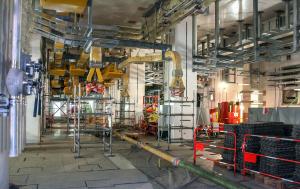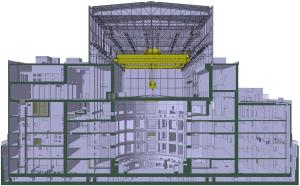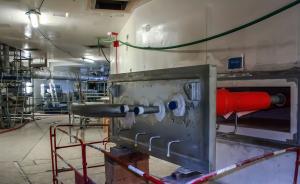Anticipation et adaptation, maîtres-mots pour l'installation des systèmes
A ce jour, 10% des systèmes complexes indispensables à la production du premier plasma, à la fin de l'année 2025, sont installés.
Dans un premier temps, les travaux ont été réalisés aux niveaux B2 et B2M (« M » pour mezzanine) des bâtiments tokamak et diagnostics. Le bâtiment tritium ne sera concerné qu'une fois l'étape du premier plasma franchie. Une centaine d'ouvriers* installe des lignes cryogéniques, des tuyauteries du circuit de refroidissement, des chemins de câbles, l'équipement du système de ventilation et de climatisation (HVAC) et des échafaudages. Ils s'assurent également de l'arrivée des matériaux indispensables aux prochaines opérations d'installation.
Les séquences qui rythment le processus d'installation ont été planifiées dans les moindres détails. Elles débutent au niveau B2, au plus profond des bâtiments tokamak et diagnostics. Les entreprises sélectionnées mettent en place les systèmes dans une zone donnée, puis progressent dans le sens anti-horaire autour du puits d'assemblage du tokamak. Une fois la rotation complète, les ouvriers passent au niveau supérieur, le B1. Jour après jour, les équipes installent et connectent les systèmes et les équipements qui alimenteront la machine. Le ballet ainsi organisé connaîtra un pic d'activité en 2022 et 2023.
Deux défis principaux s'imposent au service responsable du processus d'installation au sein du complexe tokamak. Le premier concerne l'allocation de l'espace dans les zones où les entreprises travaillent et les séquences d'installation à suivre pour une avancée optimale des travaux. En d'autres termes: quels éléments installer, à quel endroit et dans quel ordre ? La complexité est liée à la nécessité d'éviter tout conflit dans la progression des travaux et au respect des mouvements des éléments à l'intérieur des bâtiments, ainsi qu'entre ou au travers de systèmes déjà présents comme les lignes cryogéniques et les barres d'alimentation déjà en place.
Les supports sont installés les premiers, suivis par les chemins de câbles ainsi que le système de ventilation et de climatisation, arrimés au plus près du plafond. Les équipes redoutent avant tout de devoir revenir sur leurs pas et pour désinstaller des éléments. Elles gardent donc constamment à l'esprit deux images radicalement différentes : l'état des espaces en un instant « t » et leur état prévu une fois les travaux achevés. Prenant en compte le cheminement des lignes cryogéniques et des barres d'alimentation, les supports et systèmes sont progressivement installés et soudés aux plaques d'ancrage prévues pour supporter la charge associée.
Le second défi est multiple puisqu'il concerne 4 600 « pénétrations », qui sont autant d'ouvertures permettant le passage des tuyauteries, câbles, équipements de diagnostic et de ventilation et climatisation entres les pièces et les bâtiments. Dans le complexe tokamak, certaines pénétrations ont été ménagées dans des murs particulièrement importants du point de vue de la sûreté, comme ceux du bâtiment tokamak lui-même (1,5 mètre d'épaisseur) ou ceux qui entourent le puits d'assemblage de la machine (3 mètres d'épaisseur).
Les lignes cryogéniques, les barres d'alimentation et les pénétrations sont autant d'éléments à prendre en compte pour déterminer la séquence d'installation la plus efficace. En dépit d'une organisation millimétrée, les équipes qui réalisent ces travaux inédits sont parfois contraintes de s'adapter à la dernière minute. Les responsables de l'installation disposent alors de méthodes pour identifier et résoudre les difficultés qui se présentent, tout en veillant à respecter le calendrier.
Pour en savoir plus sur l'assemblage des systèmes, rendez-vous sur cette page sur le site Internet d'ITER.
* Les équipes construction d'ITER Organization et le Consortium MOMENTUM qui assure la maîtrise d'ouvrage coordonnent les activités quotidiennes du chantier. Pour le Complexe tokamak, trois contrats principaux couvrent l'ensemble des travaux : TCC0, TCC1 et TCC2.




